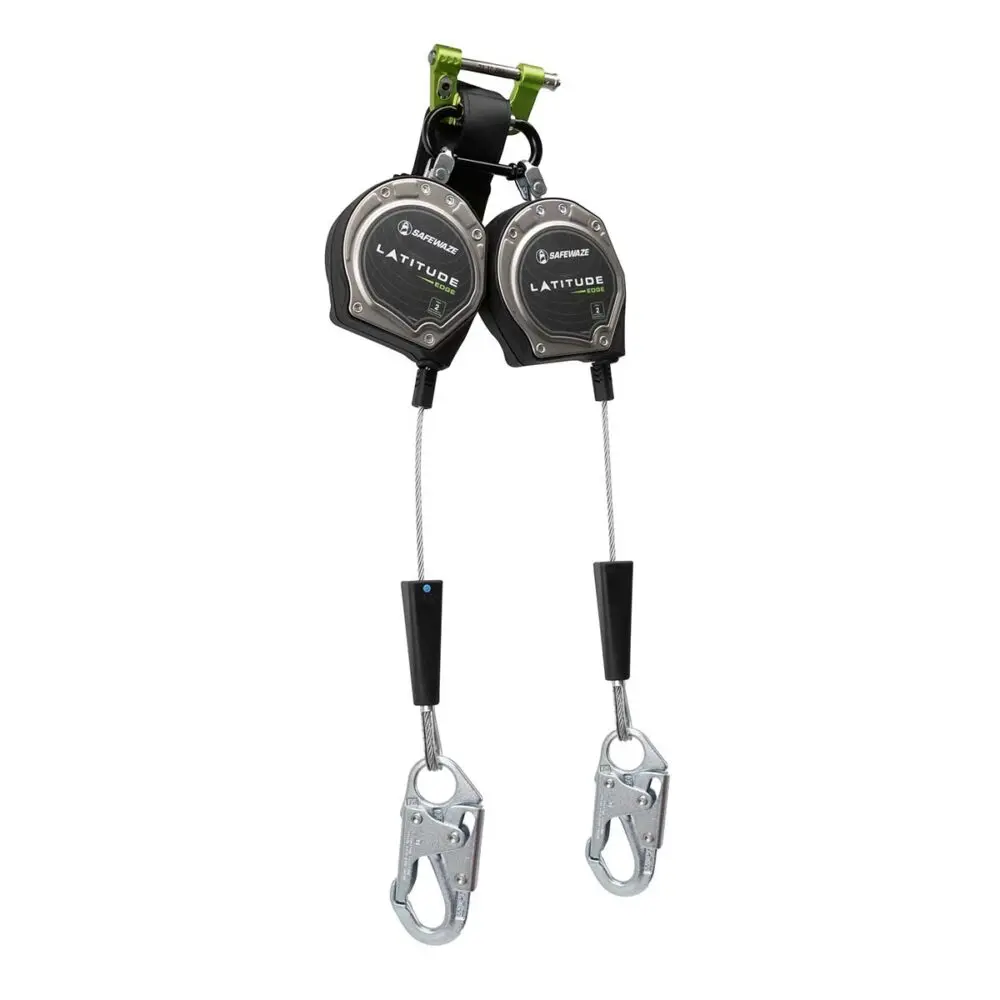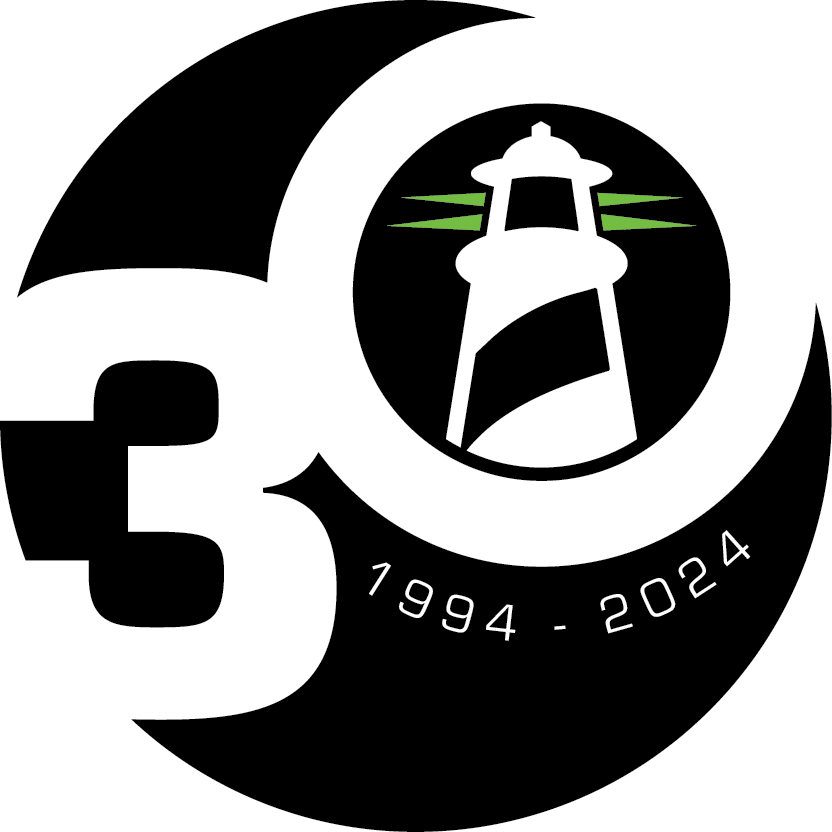A VLL must be securely attached at the top and may or a not be attached at the bottom depending on application. They can be designed for use by one or multiple workers who use a positioning device, such as a rope grab, attached at the sternal (front) D-ring to control the worker’s movement up and down. The bottom end of the lifeline must be designed to ensure the rope grab does not slip off the lifeline and all VLLs must meet the OSHA guideline for minimum breaking strength of 5,000 lbs. These lifelines provide security in fall arrest and fall restraint for ladder and tower climbing as well as in roofing and general construction.
A VLL must be securely attached at the top and may or a not be attached at the bottom depending on application. They can be designed for use by one or multiple workers who use a positioning device, such as a rope grab, attached at the sternal (front) D-ring to control the worker’s movement up and down. The bottom end of the lifeline must be designed to ensure the rope grab does not slip off the lifeline and all VLLs must meet the OSHA guideline for minimum breaking strength of 5,000 lbs. These lifelines provide security in fall arrest and fall restraint for ladder and tower climbing as well as in roofing and general construction.
An HLL must be securely anchored at both ends and may also include intermediate anchor points. Designed for use by one or more workers, HLLs may be anchored overhead or at foot level. Connection is made with a device (Personal SRLs – SRL-Ps) that attaches the user to the HLL, or via an SRL that is anchored to the HLL and extended to connect to the user’s dorsal (back) D-ring. Connection to the HLL should be facilitated using an ANSI Z359.12-2019 compliant steel O-ring. User(s) should avoid direct connection to the HLL with a snap hook or carabiner as this may result in premature wear of lifeline components. All HLLs must comply with OSHA regulation 1926.502 and be, “designed, installed, and used under the supervision of a qualified person as part of a complete personal fall arrest system which maintains a safety factor of at least two.” These systems can provide increased freedom of movement while working on rooftops and in construction as well as providing fall protection solutions for window-washing, confined space operations and scaffolding.
A VLL must be securely attached at the top and may or a not be attached at the bottom depending on application. They can be designed for use by one or multiple workers who use a positioning device, such as a rope grab, attached at the sternal (front) D-ring to control the worker’s movement up and down. The bottom end of the lifeline must be designed to ensure the rope grab does not slip off the lifeline and all VLLs must meet the OSHA guideline for minimum breaking strength of 5,000 lbs. These lifelines provide security in fall arrest and fall restraint for ladder and tower climbing as well as in roofing and general construction.
An HLL must be securely anchored at both ends and may also include intermediate anchor points. Designed for use by one or more workers, HLLs may be anchored overhead or at foot level. Connection is made with a device (Personal SRLs – SRL-Ps) that attaches the user to the HLL, or via an SRL that is anchored to the HLL and extended to connect to the user’s dorsal (back) D-ring. Connection to the HLL should be facilitated using an ANSI Z359.12-2019 compliant steel O-ring. User(s) should avoid direct connection to the HLL with a snap hook or carabiner as this may result in premature wear of lifeline components. All HLLs must comply with OSHA regulation 1926.502 and be, “designed, installed, and used under the supervision of a qualified person as part of a complete personal fall arrest system which maintains a safety factor of at least two.” These systems can provide increased freedom of movement while working on rooftops and in construction as well as providing fall protection solutions for window-washing, confined space operations and scaffolding.
A VLL must be securely attached at the top and may or a not be attached at the bottom depending on application. They can be designed for use by one or multiple workers who use a positioning device, such as a rope grab, attached at the sternal (front) D-ring to control the worker’s movement up and down. The bottom end of the lifeline must be designed to ensure the rope grab does not slip off the lifeline and all VLLs must meet the OSHA guideline for minimum breaking strength of 5,000 lbs. These lifelines provide security in fall arrest and fall restraint for ladder and tower climbing as well as in roofing and general construction.
Horizontal lifelines, known as HLLs, and vertical lifelines, known as VLLs, are important tools used as part of a complete fall protection system, providing anchorage for use with the appropriate harness and connector. Both types of lifelines utilize high-strength cable or rope which acts as the secure attachment point for fall arrest or fall restraint. They can be permanent or temporary. As the names imply, an HLL runs side to side (horizontally) while a VLL runs up and down (vertically) offering the worker additional range and mobility.
An HLL must be securely anchored at both ends and may also include intermediate anchor points. Designed for use by one or more workers, HLLs may be anchored overhead or at foot level. Connection is made with a device (Personal SRLs – SRL-Ps) that attaches the user to the HLL, or via an SRL that is anchored to the HLL and extended to connect to the user’s dorsal (back) D-ring. Connection to the HLL should be facilitated using an ANSI Z359.12-2019 compliant steel O-ring. User(s) should avoid direct connection to the HLL with a snap hook or carabiner as this may result in premature wear of lifeline components. All HLLs must comply with OSHA regulation 1926.502 and be, “designed, installed, and used under the supervision of a qualified person as part of a complete personal fall arrest system which maintains a safety factor of at least two.” These systems can provide increased freedom of movement while working on rooftops and in construction as well as providing fall protection solutions for window-washing, confined space operations and scaffolding.
A VLL must be securely attached at the top and may or a not be attached at the bottom depending on application. They can be designed for use by one or multiple workers who use a positioning device, such as a rope grab, attached at the sternal (front) D-ring to control the worker’s movement up and down. The bottom end of the lifeline must be designed to ensure the rope grab does not slip off the lifeline and all VLLs must meet the OSHA guideline for minimum breaking strength of 5,000 lbs. These lifelines provide security in fall arrest and fall restraint for ladder and tower climbing as well as in roofing and general construction.
Horizontal lifelines, known as HLLs, and vertical lifelines, known as VLLs, are important tools used as part of a complete fall protection system, providing anchorage for use with the appropriate harness and connector. Both types of lifelines utilize high-strength cable or rope which acts as the secure attachment point for fall arrest or fall restraint. They can be permanent or temporary. As the names imply, an HLL runs side to side (horizontally) while a VLL runs up and down (vertically) offering the worker additional range and mobility.
An HLL must be securely anchored at both ends and may also include intermediate anchor points. Designed for use by one or more workers, HLLs may be anchored overhead or at foot level. Connection is made with a device (Personal SRLs – SRL-Ps) that attaches the user to the HLL, or via an SRL that is anchored to the HLL and extended to connect to the user’s dorsal (back) D-ring. Connection to the HLL should be facilitated using an ANSI Z359.12-2019 compliant steel O-ring. User(s) should avoid direct connection to the HLL with a snap hook or carabiner as this may result in premature wear of lifeline components. All HLLs must comply with OSHA regulation 1926.502 and be, “designed, installed, and used under the supervision of a qualified person as part of a complete personal fall arrest system which maintains a safety factor of at least two.” These systems can provide increased freedom of movement while working on rooftops and in construction as well as providing fall protection solutions for window-washing, confined space operations and scaffolding.
A VLL must be securely attached at the top and may or a not be attached at the bottom depending on application. They can be designed for use by one or multiple workers who use a positioning device, such as a rope grab, attached at the sternal (front) D-ring to control the worker’s movement up and down. The bottom end of the lifeline must be designed to ensure the rope grab does not slip off the lifeline and all VLLs must meet the OSHA guideline for minimum breaking strength of 5,000 lbs. These lifelines provide security in fall arrest and fall restraint for ladder and tower climbing as well as in roofing and general construction.



